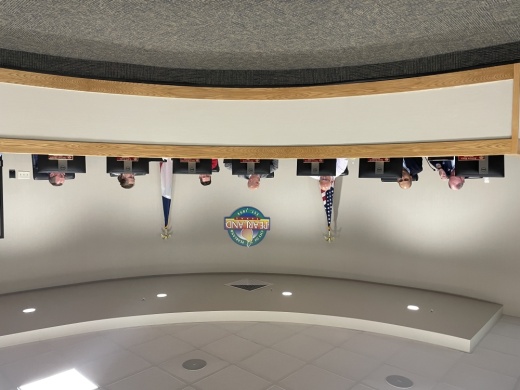After much debate, Pearland City Council on Sept. 12 approved the first reading of the FY 2022-23 budget and property tax rate. Staff plans to return to council before the second reading Sept. 26 with potential ways to reduce the budget and tax rate, which may effectively lower the water rate increases.
The budget as passed stands at $110.26 million in general fund expenses, making it, as Council Member Alex Kamkar said, the largest budget in Pearland’s history. For comparison, the FY 2021-22 budget was $99.62 million when originally passed, though it was amended up to $106.98 million, according to city documents.
Major changes in the FY 2022-23 budget include hiring four new firefighters to balance shifts, hiring two telecommunications operators and one police officer, hiring new drainage maintenance crew members, updating the city’s master drainage plan and purchasing police equipment.
In addition, the budget raises pay 5.5% for city employees—6.5% for police and fire department employees—and increases sick leave buyback from 40 hours to 60. Sick leave buyback allows employees to annually trade in unused sick time for money.
All told, these additions and changes total $5.1 million.
“We’re shaping our future with purpose, and we’re committed to the public safety, our employees and building our future together,” City Manager Clay Pearson said.
Kamkar and Council Members Adrian Hernandez and Layni Cade voted against the budget as proposed, all hoping to cut it down further during a time of recession.
Kamkar pointed out the difference between the originally proposed FY 20221-22 and FY 2022-23 general fund expenses is nearly $10.7 million.
“I struggle because the city expenditures are going faster than inflation,” he said. “I’ve just been consistent on this budget. This is the one that right now the citizens of Pearland can’t afford during this recession.”
Hernandez proposed eliminating some of the budget’s major changes to effectively reduce the budget, tax rate and water rate increases but never made a formal motion. Instead, staff will return with potential cuts to help reduce the budget.
Rate increases
Perhaps the biggest change in the FY 2022-23 budget for residents is the fact that it includes a 13.1% water rate increase.
Most Pearland residents will not see a flat 13.1% increase, however. The average household in Pearland uses 6,000 gallons of water per month and will pay about $7.50 more a month, which is an increase of 9.5%. This is due to various factors, including moving off the 32/30 plan.
Driving the water rate increase is a $535.1 million investment in projects to expand and upgrade water systems. Pearland’s new surface water treatment plant will be operation in FY 2022-23, and other water reclamation and plant facilities will be improved and expanded.
The rate increases will not stop at 13.1%; the FY 2023-24 through FY 2026-27 budgets calls for additional annual increases ranging from 8% to 19%.
A few council members asked why an extra $1.4 million in revenue the city received in the FY 2021-22 budget due to the drought could not help lower the proposed rate increase. City officials said the money is earmarked to offset future debt and would not have a huge effect on rates.
“There’s zero pity for the people that actually have to buy the water,” Kamkar said of the rate increase. “I struggle with that.”
Mayor Kevin Cole agreed the rate increase is high.
“Nobody likes to pay a 13% increase. I don’t want to pay it,” he said. “But I also want to make sure we pay our bills and deliver our projects, so we’ve got to figure that out.”
In addition, residents’ solid waste fee is set to increase as part of the budget.
Today, a Pearland resident pays $18.26 a month for trash pickup; this will increase to $19.25—a 5.42% increase.
Tax rate
The tax rate as passed to fund the budget is $0.623765 per $100 valuation. Earlier in the budget process it was $0.628765, but after workshops and discussion, council and staff removed $0.005 from the debt service rate, lowering the overall rate by the same amount.
Under this rate, the owner of a $300,000 home would pay $1,871.30 to the city in property taxes.
While last year’s tax rate was nearly $0.08 higher at $0.701416, that rate was below the no-new-revenue rate, which is defined as the rate by which the city would collect the same amount in property tax revenue as it had the year before. The FY 2022-23 rate, however, is above the no-new-revenue rate of $0.543044, prompting some to push for it to be lowered.
Mayor Kevin Cole pointed out the term “no-new-revenue rate” is not exactly accurate. According to the state comptroller, the no-new-revenue rate includes several exclusions and calculations that results in the no-new-revenue rate not exactly being the amount that brings the city no extra revenue compared to the previous year, he said.
For instance, despite being below the FY 2020-21 rate and the no-new-revenue rate, the FY 2021-22 tax rate ended up being a tax increase to residents. Had City Council passed the rate at the no-new-revenue rate, the city would have brought in $6 million extra in FY 2021-22 revenue than it had the year before, City Manager Clay Pearson said.
Despite voting against the budget, both Hernandez and Cade voted in favor of the tax rate to support the passed budget. Had the tax rate not passed with at least five of the seven members in favor, the tax rate would have automatically reverted to the no-new-revenue rate, forcing city staff to significantly reduce the budget.
Both Hernandez and Cade said they wanted to see the budget reduced but that the city cannot accomplish what it needs to at the no-new-revenue rate and therefore voted in favor of the proposed tax rate. Kamkar, however, was the sole dissenting vote, reiterating he does not support such a high budget.





